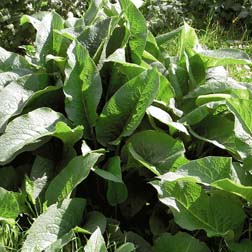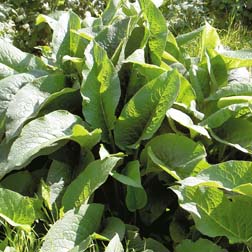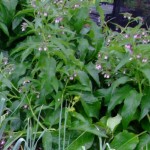Comfrey which to grow
by Diane - October 2nd, 2012.Filed under: Thompson and Morgan.
Not sure which comfrey to grow?
If you’ve heard of comfrey but can’t decide
which comfrey to grow
then you should consider the following points:

Comfrey ‘Bocking 14’ – 5 root cuttings £8.99
Grow your own soil conditioner! Comfrey ‘Bocking 14’ contains high levels of basic NPK nutrients and because it is a sterile hybrid, it won’t self seed all over your garden. The nutrient rich foliage of comfrey can be used as a compost activator, mulch, or soaked in barrels of water for 3 to 5 weeks to make a useful liquid feed for tomatoes and beans. Scatter the wilted leaves throughout potato trenches just before planting, to fertilise the crop and improve their flavour! Once established, this quick growing plant can be cut 3 or 4 times throughout the growing season, for a constant supply of nutrient rich, organic, comfrey fertiliser. Height: 100cm (40”). Spread: 75cm (30”).

Comfrey – 1 packet (30 seeds) £2.49
Comfrey leaves can be harvested several times a season and used as a compost activator to help breakdown other compost materials. This perennial herb is also used as a mulch, and makes superb liquid manure on tomato and potatoes plants. Height: 120 (47″). Spread: 150cm (59″).
I ordered both of these from Thompson and morgan earlier in the year.

The comfrey roots are bocking 14 and won’t set seed. Every advises to get this version as the seeding version can be a nuisance.
I planted the short pieces of dark root in pots of compost at home and waited. It was exciting to see leaves emerging after a short while and as the plants grew I made sure they were protected from slugs. Although slugs aren’t supposed to eat comfrey leaves – the baby leaves were apparently delicious to slugs. A liberal sprinkling of slug pellets ensured all five grew well. If you don’t like using slug pellets then get some nemotodes as they’ll make a huge difference to your growing and cropping!
The five pots of root were soon big enough to plant out. I planted them in a row in the middle of one of the beds on my allotment. I figured next to a path was a good idea so I could harvest the first cut of leaves next year without clambering over planted ground.
The plants were only small when I put them out but they rapidly grew.
They’re now pretty big and I’ve not cut it back at all this year. I am letting the plant get established. It’s also flowered and the bees have absolutely loved the beautiful bell like flowers.
You can apparently shovel manure on to comfrey and it’ll love it. It is a good idea to feed comfrey although its roots will go far down you’ll find all plants benefit frmo feeding. but well rotted manure is great for this – just throw it on.
You propogate bocking 14 comfrey by root cuttings so I am considering digging a plant up next spring and dividing it up. This should provide me with many more plants to plant across the borders in the allotment site to provide other people with this valuable resource.
I have also grow comfrey from seed. This variety will also grow from the seed it sets itself. The plants are small but I suspect next year they will be bigger. The seeds obviously take a longer time to be ready to plant out.
If comfrey setting seed and creating new plants will be a problem then stick to the bocking 14 variety as this is the best option for limited space. If you’ve got lots of garden you’d like to fill with a useful plant then get the seeded version.
Of course if this comfrey self sows you can move the plants. Just try to get all the root as it will also grow from root. In theory this should be an easy way of getting enough comfrey plants to put in the shade corners of the allotment site to create some lovely flowers for the bees.
I will write again about the comfrey next year – both how it grows and how I use it. It can be cut down four times a year which makes it a great resource for plant food. WHere can you plant it? Both prefer full or partial sun so pick a position where it has plenty of room and with good soil that is rich and moist. Remember you can enrich soil in autumn by emptying a bucket load of muck on them.
| Bocking 14 | Symphytum officinale |
| Very vigorous | The true comfrey (Symphytum officinale) is a bit less vigorous of a grower, |
| more elongated leaves | |
| pale flowers | darker flowers |
| Doesn’t set seed | does indeed make seed Can spread by self-seeding and become a nuisance. |






